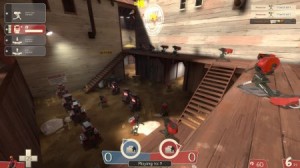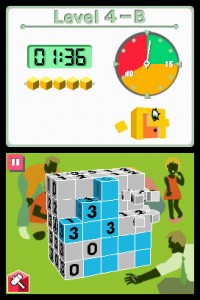Player Creativity, And The Power Of Illusion
- Updated: 12th Mar, 2012
I wrote in a previous piece that destruction is the best way to make the player feel powerful. There is one more effective method – destruction’s opposite: creation. However, despite being the engine powering the success of The Sims, Minecraft, and the legions of Tycoon games, its seldom seen in more “traditional” games. Why is this?
 The first, and probably most obvious reason is that destruction is more useful for narrative games. Game stories are almost exclusively adversarial. Kill The Evil Ones! Destroy Their Stuff! Creating ever more complex glasshouses, and roller coasters, as I do in Minecraft, doesn’t propel a narrative. However, this alone, does not exempt narrative games from encouraging player creativity and providing the player with choices.
The first, and probably most obvious reason is that destruction is more useful for narrative games. Game stories are almost exclusively adversarial. Kill The Evil Ones! Destroy Their Stuff! Creating ever more complex glasshouses, and roller coasters, as I do in Minecraft, doesn’t propel a narrative. However, this alone, does not exempt narrative games from encouraging player creativity and providing the player with choices.
Much as I don’t like debates on what a game is, I feel we may need to briefly address it here.
One definition says that games are “constrained fun”. This is interesting because the constraints play two roles. They create the fun, and they also maintain it by keeping the game balanced.
It follows from this, that even when games look free, open, and full of player choice, they are actually constrained by strict rules. My dream game involves creatively solving problems in a narrative-focused (but including a good bit of action) experience. However, the above is the first roadblock for my dream game, as well as for player creativity and player choice in general.
The second roadblock comes from the way games are made and funded. If we were trying to design an encounter for a game, we’d begin by roughing out the geometry and the key obstacles. We’d then run the encounter in our heads, thinking of ways to make it interesting, and of things people might like to do.
For example: there’s a walkway over a chasm that’s patrolled by guards. At its most basic we can have two options:
- Fight the guards and cross the walkway.
- Sneak under the walkway, weaken all of the supports, find the hidden path and cross.
Most people can get to this point and they could come up with loads of other cool things for the player to do. However, games have budgets and the publisher will have expectations of a particular return on investment. So for this encounter, what a designer has to decide is the following:
- Is this a undermining-things game? Can we make the undermining things fun.
- Will our core audience enjoy undermining the walkway?
- With respect to the cost of implementing undermining the walkway – animation, particles, physics – am I going to use it enough?
So from the almost-infinite number of ways a human would approach a problem (almost all of them, differing very little from each other but still a huge number), through play-testing, and polishing, and cost-benefit analysis, it gets boiled down to three at best. However, even with play-testing, none of the available options may be the way you want to approach it.
 One final roadblock comes from what we are using to control the game; a computer. At its core, a video game is a system and, because we can’t monitor it, it has to be a closed system.
One final roadblock comes from what we are using to control the game; a computer. At its core, a video game is a system and, because we can’t monitor it, it has to be a closed system.
What I mean by a closed system, is that the user cannot modify it. For example, in an FPS, I cannot modify the rate of fire of the guns while I am in the game.
This system has a limited number of inputs, which produce deterministic outputs, i.e. every time the system receives an input, it provides the same output, or at least one in a pre-set range. This allows us to feed our game into a computer, and for the computer to be able to handle it and not catch fire. Almost the textbook definition of creation is the injection of new things, or new behaviours into a system.
Yeah… that’s a problem. Computers can’t think; they’re only just beginning to do natural language processing. IBM’s Watson is the furthest along – it’s able to give top Jeopardy players a run for their money. However, the days of a computer being able to accept a request from the player, understand it, and then make a balanced judgement. As well as implement the judgement in real time, are a long way away. Sadly, that’s exactly what we need them to be able to do for creative problem solving to be a viable aspect of narrative based or open world games. Its a sad fact that the more game you want to have, the less creativity and player choice you can have.
 This is why I’m so jealous of Dungeons & Dragons. I’ve never played it but I have listened to the excellent Wizards of the Coast podcasts featuring the guys behind web-comics Penny-Arcade and PVP, as well as actor/Internet hero Wil Wheaton. I highly recommend them to anyone who is a fan of games, D&D or just a fan of interesting, very funny people.
This is why I’m so jealous of Dungeons & Dragons. I’ve never played it but I have listened to the excellent Wizards of the Coast podcasts featuring the guys behind web-comics Penny-Arcade and PVP, as well as actor/Internet hero Wil Wheaton. I highly recommend them to anyone who is a fan of games, D&D or just a fan of interesting, very funny people.
The main thing I picked up on was the role of the DM (Dungeon Master, Chris Perkins) and the way he worked to include any crazy thing the guys wanted to do. I was amazed at how he was able to take their ideas, and quickly formulate a skill check that made sense, and maintained the integrity of the game. At its core, D&D appears to be about collaborative storytelling, along with the ability, if you have a great DM, to solve problems creatively, and in your own way.
D&D can achieve this flexibility, and video games can’t, for a couple of reasons.
- Everything is free
If the players want to do something, they can do it. No polygons have to be teased into complex forms. No new behaviour has to be coded, and tested. No animator needs to get animated. As many one-off events as you like can be added, as long as a credible skill check can be formulated. There’s no pressure to reuse anything, as they didn’t cost anything. - There’s less expectation of a polished product, and the ability to retcon.
At the AAA level, games are expensive, as a result gamers expect smooth, well polished experiences. In D&D, if a choice unbalances a game, the players are less annoyed as they are not significantly out of pocket, and it can be fixed on the fly. - It’s turn-based
While not an advantage over a computer, it is how D&D gets the most out of its DM.
A human would be unable to cope with a stream of complex requests from multiple players. However, they can cope quite well with one at a time.
The real lesson from D&D is that you can have real creativity in a system constrained by rules, and limits if you can make these rules, and limits flexible. A human overseer is a terrific way to do this.
What could we have if creation was truly possible in video games? Well, I’ve wanted a cross between Team Fortress 2 (TF2) and Minecraft for a long time. TF2 should be a game about building defences and holding onto a fort, and it is that… kinda. However, its constraints prevent it from fully fulfilling this
 Asynchronous gameplay is something which is very interesting to me. It means some players playing a different game, or the same game differently, to the majority of players. The above-ground chaos of TF2, coupled with the engineers undermining bits of the opposing forts in a Minecraft style and setting traps in their own fort, would be special.
Asynchronous gameplay is something which is very interesting to me. It means some players playing a different game, or the same game differently, to the majority of players. The above-ground chaos of TF2, coupled with the engineers undermining bits of the opposing forts in a Minecraft style and setting traps in their own fort, would be special.
However, as well as the technical issues, balancing this would be an absolute nightmare. If players can dig anywhere they like on the game map, you can’t count on anything going on below ground. Chokepoints, and other fun ways of bringing the opposing teams together, are now unpredictable, and cannot be preset. You’d need a computerised DM to oversee the game, and make lightning quick decisions.
As such a DM is a long way off, the designers at Valve have created defensive archetypes, and built maps with choke-points designed for them. Players feel great when they stick a turret in a good spot, even though they were always meant to put it there. This is the illusion of creativity. It’s great, because it’s almost as powerful as true creativity, but much more controllable, balance-able, and easier to fit into the wider game.
Another example would be the skate parks in the Tony Hawk series. Players feel great building runs and finding ways to link tricks together. However, this is not real creativity. It’s not a lot better than tracing a drawing, but it works. The player feels good, and the developers can be pretty sure that every player will feel good.
 My favourite example of the power of this illusion is 2009’s Picross 3D for the Nintendo DS. For those who don’t know, Picross is a series of games dating back to the the Gameboy. The concept behind them, is a type of number puzzle called a nonogram.
My favourite example of the power of this illusion is 2009’s Picross 3D for the Nintendo DS. For those who don’t know, Picross is a series of games dating back to the the Gameboy. The concept behind them, is a type of number puzzle called a nonogram.
The player is given a grid – or in Picross 3D, a collection of cubes forming a 3D shape – with number clues on it. The clues tell the player which of grid-squares/cubes are part of an object contained in the puzzle, and which can be chipped away.
The genius behind Picross 3D is the way it makes you feel like you made the object contained in the puzzle. It feels like a carving simulator sometimes. The combination of the stylus tapping and a really great stone chipping sound makes it feel like you’re carving the object out of a rock. There’s zero creation involved here, as there is only one solution which was set when the game shipped. This is illusion at its best.
So true creation or player creativity is not present in mainstream games and to be honest, until we are able to control the consequences of it, this is probably a good thing. It’s a good thing, because we have the illusion to fall back on.
The problem is that not enough games are taking advantage of it. The value of this illusion for narrative games is that it elicits similar feelings from players to those that Minecraft does, but the developer doesn’t have to give up the storytelling and control advantages of more traditional game structures.
As my site bio says, I have a lot of imaginary conversations. These are okay, however they can get a little tedious as I’m always right. I’d love to hear your thoughts on creation in games and how you feel games will change in the coming 20-50 years. Talk to me in the comments section.

9 Comments